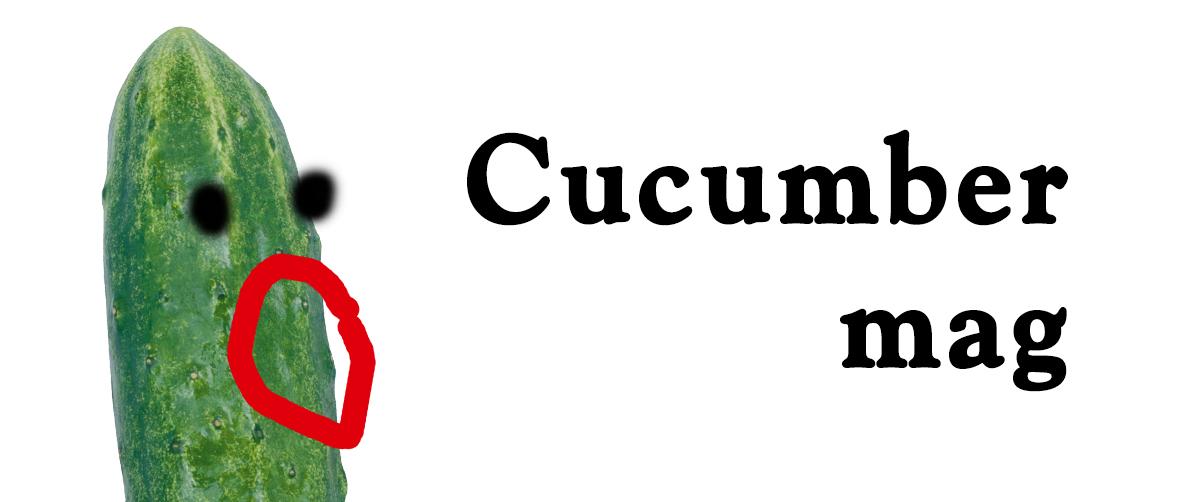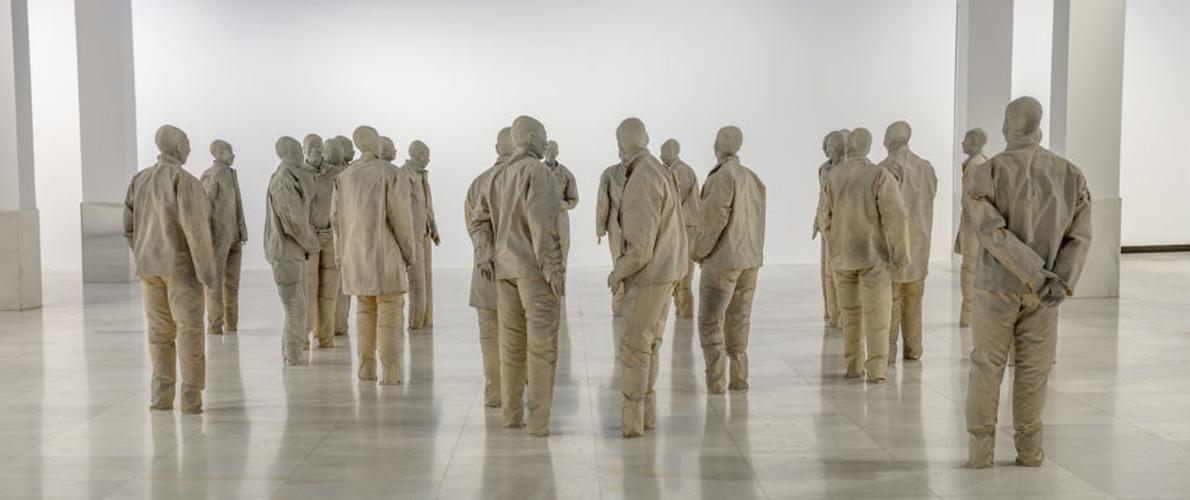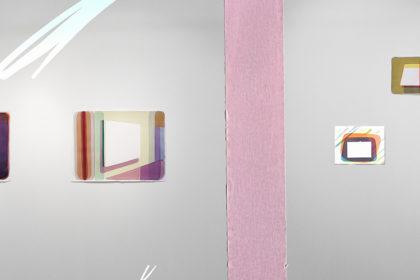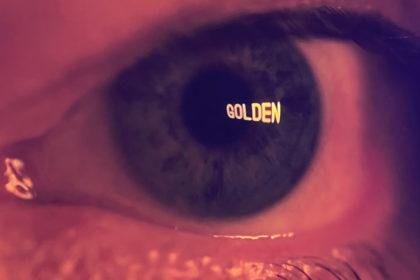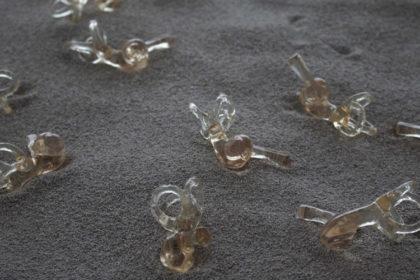Author: Sarah Crozier
Everybody remembers the first installation in the Turbine Hall of the Tate Modern, by Louise Bourgeois, but not so many remember the second. And yet Spanish sculptor Juan Muñoz’s architectural and figurative intervention Double Bind, which opened in June 2001, was the pinnacle of his career and marked him as Spain’s foremost contemporary artist. It was still on show when he died two months later of an aneurysm at the age of 48.
“Everything I see will outlive me” is the first of two exhibitions in Madrid this year, marking what would have been Muñoz’s 70th birthday. The show takes its title from a line by Russian poet Anna Akhmatova, which appeared in the catalogue for Double Bind, presciently scribbled down by the artist on a post-it note.
The Sala Alcalá 31, an exhibition space in the centre of Madrid, presents an overview of the final decade of the artist’s work, on show until 9 July. On 17 June, an exhibition of his earlier work will open in the Centro de Arte Dos de Mayo (CA2M), one of the many local contemporary art centres established across Spain in the years before the 2008 financial crisis. Both exhibitions are curated by Manuel Segade, who has just been appointed to the prestigious post of Director of the Reina Sofía Museum.
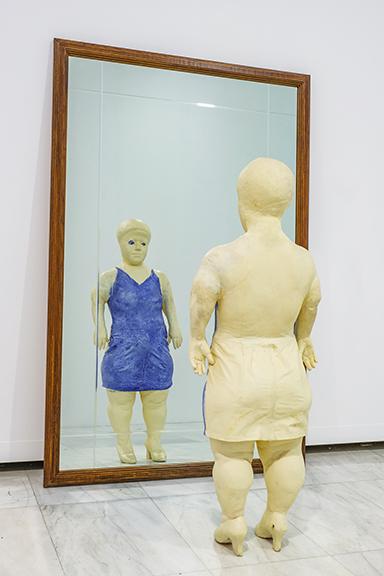
Juan Muñoz, Sarah with Blue Dress, 1996. Photo: Guillermo Gumiel
Muñoz’s signature grey figures pervade the exhibition space, cackling from chairs affixed high up on the walls, gossiping in corners, or gazing at their own reflections. They never make eye contact with the spectator but, despite their conspiratorial expressions, neither do they engage directly with one another. They are superficially in community but ultimately each in their own world.
Dominating the central hall is Plaza, a mass of peg-legged figures with East Asian faces, dressed like workers and engaged in animated yet disconnected conversations. As in a game of Chinese whispers, we never quite grasp what they are saying. It’s an unsettling work that marks a them and us, a division only reinforced when members of the public walk between the huddled groups, inadvertently part of the performance, and make evident their slightly smaller-than-human scale. While not all Muñoz’s characters have these Asian features, they are a recurring theme in his work and one that marks the passage of the past two decades; whatever the intention, it is hard to imagine that a white man would use racial representations so easily and unambiguously today.
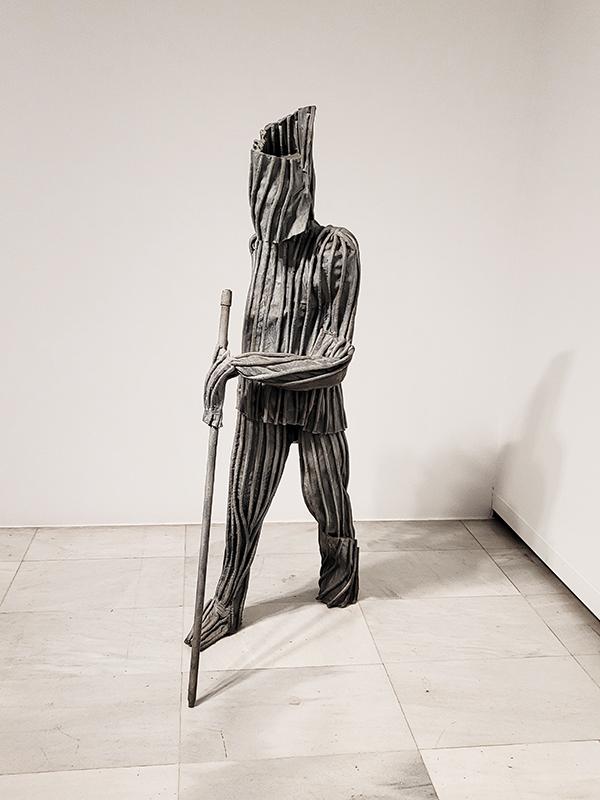
Juan Muñoz, Blotter Figures: Coming Towards, 1999. Photo: Sarah Crozier
Muñoz left Spain shortly after Franco’s death. Earlier, he had spent a couple of years studying architecture in Madrid – an influence that can be seen in his spatial interventions and use of pillars, floors and balconies. But his artistic training was largely in the Anglo-Saxon world, at Croydon College and the Central School of Art and Design in London, and later at the Pratt Centre in New York. With more than 50 solo exhibitions worldwide and appearances at Documenta IX and multiple Venice Biennales, his success was at once celebrated by Spanish critics and lamented for representing an exception to the otherwise meagre international presence of Spanish contemporary art. It’s a preoccupation that has been present in the Spanish art scene since the democratic transition, with commentators fretting about whether the country has fully joined the international club – or indeed whether that is even still the goal in a culturally diverse and multi-centred world.

Juan Muñoz, Exposition view, 1999. Photo: Guillermo Gumiel
Despite Muñoz’s wider European and North American influences, critics have often tried to look for a Spanishness in his work. Sarah with Blue Dress features a woman with dwarfism staring with dark eyes at her own reflection, a blue dress rendered on the front of an otherwise unpainted form. She sees a more appealing version of herself, suddenly alive with colour, than we do from the back. Seeing references to Velázquez in this and his other dwarf sculptures, Roberta Smith of the New York Times found his work “indelibly Spanish”. Perhaps Muñoz shared with Velázquez an ability to depict difference sympathetically, but seeking national characteristics seems forced. Muñoz predated the ubiquity of smartphones, but the recurring motif of mirrors perfectly captures our current obsession with our own image.
Upstairs, more grey figures await, one suspended from the ceiling by his mouth, spinning above the monotone crowd below. Anonymous “Blotter Figures”, made of ribbed felt, represent absorption through both their material and their inward-looking, isolated poses. They look like alien cleaners, able to seep up and sweep up as they go, with that singular creepiness inherent to faceless figures.
Muñoz’s work succeeds by being timeless and universal in its sense of alienation – by conveying the feeling of not being in the in-crowd. Whether the clique today is the international art scene, the cool kids’ WhatsApp group or the narcissism and false connections of social media, it seems that Muñoz has seen it all before and – sadly – it has outlived him.
Juan Muñoz. Todo lo que veo va me sobrevivrá, curated by Manuel Segade, is on show at the Sala Alcalá 31, Madrid until 9 July 2023.
Juan Muñoz. En la hora violeta will run in Museo Centro de Arte Dos de Mayo in Mostoles, Madrid from 17 June 2023 until 7 January 2024
Sarah Crozier graduated in Fine Art & Art History from Goldsmiths in London in 2000, and has recently returned to art after a number of years working around the world in human rights, democracy support and development. She is currently completing a Master’s degree in Contemporary Art & Visual Culture at the Reina Sofía Museum/Autonomous University of Madrid with a focus on art criticism and curation. In her writing and research she has a particular interest in Spanish contemporary art and the readings and mis-readings of Spanish art in the English-speaking world.
